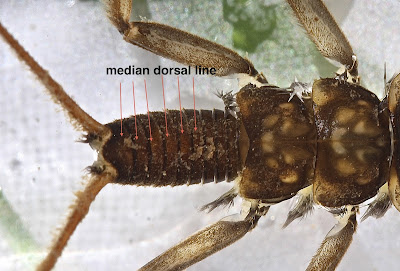Still sweating it out -- literally! -- in central Virginia, and it's supposed to be hotter next week.
Steven Beaty has confirmed that, using current species descriptions, the nymph in the photo at the top of the page appears to be Acroneuria evoluta. (See the entry of 6/12.) So, it is a species we find in the Rivanna, usually in the fall, and I've found it at Darden Towe Park in C'ville, and in Fluvanna County at the Crofton bridge. Apparently, this is the first time this species has been recorded in the state of Virginia.
________________
On 9/8/12, I posted an EPT List for central Virginia. While I've tried to update that as things have proceeded, I think it's worthwhile to post a "revised" list based that shows where things stand at the moment. Here it is.
EPT Species List for Central Virginia
(Albemarle,
Greene, Madison, Fluvanna)
I. Ephemeroptera (Mayflies)
1. Ameletidae
1. Ameletus lineatus
2. Ameletus
cryptostimulus
2. Baetidae
(Small minnow mayflies)
1. Acentrella nadineae
2. Acentrella turbida
3. Baetis flavistriga
4. Baetis intercalaris
5. Baetis pluto
6. Baetis tricaudatus
7. Heterocloeon
curiosum
8. Heterocloeon amplum
9. Heterocloeon
petersi
10. Iswaeon anoka
11. Labiobaetis
propinquus
12. Plauditus dubius
3. Isonychiidae
(Brushlegged mayflies)
1. Isonychia sp.
4. Heptageniidae (Flatheaded mayflies)
1. Cinygmula
subaequalis
2. Epeorus pleuralis
3. Epeorus vitreus
4. Epeorus fragilis
5. Heptagenia
marginalis
6. Leucrocuta hebe
7. Leucrocuta juno
8. Leucrocuta aphrodite
9. Leucrocuta thetis
10. Maccaffertium
ithaca
11. Maccaffertium
meririvulanum
12. Maccaffertium
pudicum
13. Maccaffertium
vicarium
14. Maccaffertium modestum
15. Rhithrogena sp.
(exilis?)
16. Rhithrogena sp.
17. Stenacron carolina
18. Stenacron interpunctatum
5.
Ephemerellidae (Spiny crawler
mayflies)
1. Drunella cornutella
2. Drunella
tuberculata
3. Drunella walkeri
4. Ephemerella
dorothea
5. Ephemerella invaria
6. Ephemerella
subvaria
7. Eurylophella
verisimilis
8. Eurylophella
funeralis
9. Eurylophella
sp. (minimella?)
9. Serratella
serratoides
10. Serratella serrata
11. Teloganopsis
deficiens
6. Leptohyphidae (Little stout crawler mayflies)
1. Tricorythodes
1. Caenis sp.
*8. Baetiscidae
(Armored mayflies)
1. Baetisca sp.
9. Leptophlebiidae (Pronggilled mayflies)
1. Paraleptophlebia
mollis
2. Paraleptophlebia
guttata
3. Habrophlebia
vibrans
4. Leptophlebia
10. Ephemeridae
(Common burrower mayflies)
1. Ephemera guttalata
1. Capniidae
(Small winter stoneflies)
1. Allocapnia sp.
2. Paracapnia angulata
2. Leuctridae (Needleflies)
1. Leuctra sp.
3. Nemouridae
(Forestflies)
1. Amphinemura sp.
2. Ostrocerca truncata
3. Prostoia completa
4. Soyedina sp.
4. Taeniopterygidae (Large winter stoneflies)
1. Strophopteryx
fasciata
2. Taenionema
atlanticum
3. Taeniopteryx burksi/maura
5.
Chloroperlidae (Green
stoneflies)
1. Alloperla sp.
2. Haploperla brevis
3. Sweltsa sp.
6. Peltoperlidae (Roach-like stoneflies)
1. Peltoperla sp.
2. Tallaperla sp.
3. Viehoperla sp.
7. Perlidae
(Common stoneflies)
1. Acroneuria abnormis
2. Acroneuria
carolinensis
3. Acroneuria sp.
(possibly internata, possibly a
variety of abnormis)
4. Acroneuria evoluta
5. Acroneuria lycorias
5. Agnetina annulipes
6. Agnetina capitata
7. Agnetina flavescens
8. Eccoptura
xanthenses
9. Neoperla sp.
10. Paragnetina
immarginata
11. Paragnetina fumosa
12. Perlesta sp.
8. Perlodidae
(Springflies and Stripetails)
1. Clioperla clio
2. Diploperla
duplicata
3. Helopicus
subvarians
4. Isogenoides hansoni
5. Isoperla dicala
6. Isoperla holochlora
7. Isoperla holochlora
"A"
8. Isoperla latta
9. Isoperla montana
(group)
10. Isoperla similis
11. Isoperla davisi
12. Isoperla orata
13. Isoperla orata
(variant form)
14. Isoperla sp.VA
15. Malirekus hastatus
16. Rememus bilobatus
9. Pteronarcys
(Giant stoneflies)
1. Pteronarcys biloba
2. Pteronarcys dorsata
3. Pteronarcys proteus
III. Trichoptera (Caddisflies)
1. Rhyacophilidae (Free-living caddisflies)
1. Rhyacophila
carolina
2. Rhyacophlia fuscula
3. Rhyacophila nigrita
4. Rhyacophila
glaberrima
5. Rhyacophila
ledra/fenestra
6. Rhyacophila sp.
(banksi?)
*2. Hydroptilidae (Micro caddisflies)
1. Hydroptila sp.
3. Glossosomatidae (Saddle-case makers)
1. Glossosoma nigrior
4. Philopotamidae (Fingernet caddisflies)
1. Chimarra sp.
2. Dolophilodes
distincta
3. Wormaldia sp.
5. Polycentropodidae
1. Polycentropus sp.
6. Hydropsychidae (Common Netspinners)
1. Ceratopsyche
alhedra
2. Ceratopsyche bronta
3. Ceratopsyche morosa
4. Ceratopsyche
slossonae
5. Ceratopsyche sparna
6. Cheumatopsyche sp.
7. Diplectrona modesta
8. Diplectrona metaqui
9. Hydropsyche betteni
10. Hydropsyche rossi
11. Hydropsyche
venularis
12. Macrostemum sp.
*7. Phryganeidae (Giant case-makers)
1. Phryganea sp. (sayi?)
8. Brachycentridae (Humpless case-makers)
1. Adicrophleps
hitchcocki
2. Brachycentrus
appalachia
3. Micrasema wataga
4. Micrasema charonis
5. Micrasema bennetti
6. Micrasema sp. (scotti?)
9. Lepidostomatidae
1. Lepidostoma sp. (at least 2 different species, possibly more)
2. Theliopsyche sp.
10. Limnephilidae (Northern case-makers)
1. Ironoquia
punctatissima
2. Pycnopsyche
gentilis
3. Pycnopsyche
scabripennis
4. Pseudostenophalyx
sparsus
11. Apataniidae
1. Apatania incerta
12. Goeridae
1. Goera calcarata
2. Goera fuscula
13. Uenoidae
1. Neophylax oligius
2. Neophylax
consimillis
3. Neophylax aniqua
4. Neophylax mitchelli
5. Neophylax fuscus
6. Neophylax concinnus
14. Leptoceridae (Long-horned case-makers)
1. Nectopsyche
equisita
2. Oecetis sp.
3. Ceraclea maculata
15. Odontoceridae (Strong case-makers)
1. Psilotreta labida
2. Psilotreta
frontalis
3. Psilotreta rufa
16. Molannidae
(Hooded-case maker)
1. Molanna blenda
As I've done in the past, I will make changes to this as needed.




















